Right in the middle of dense traffic stands a timeless icon of Ahmedabad, the Sidi Saiyyed Jali within the Sidi Saiyyed Mosque. As you cross the Nehru Bridge and leave the western suburbs of Ahmedabad, you enter the area known as Lal Darwaza, located on the fringes of the old city of Ahmedabad. There, virtually acting as a traffic island is an exquisite example of the rich heritage of the heritage city of Ahmedabad, Gujarat.
Table of Contents
Sidi Saiyyed Jali – Jewel Of The Sidi Saiyed Mosque
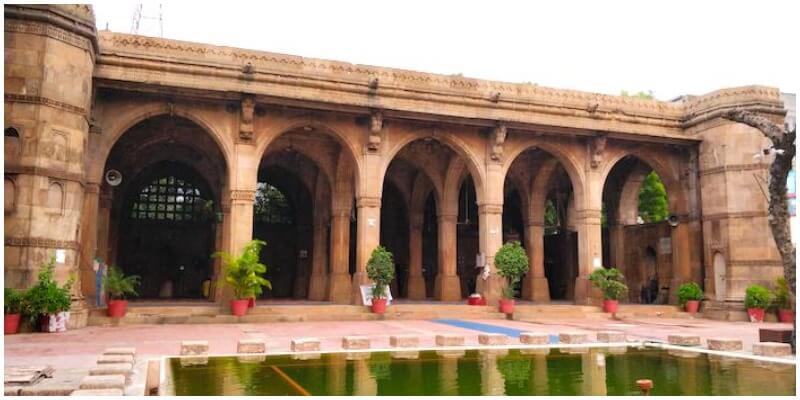
The Sidi Saiyed Jali is an enduring icon of the city of Ahmedabad that links its present to the past. The exquisite carvings that form the Sidi Saiyyed Jali feature in the logo of one of the most prestigious educational institutes in the country, the Indian Institute of Management(IIM), Ahmedabad. But what is the Sidi Saiyyed Jali and why is it so famous? Read on to know all about the history of Sidi Saiyyed Jali and the architecture of the Sidi Saiyyed Mosque.
What Is The Sidi Saiyyed Jali?
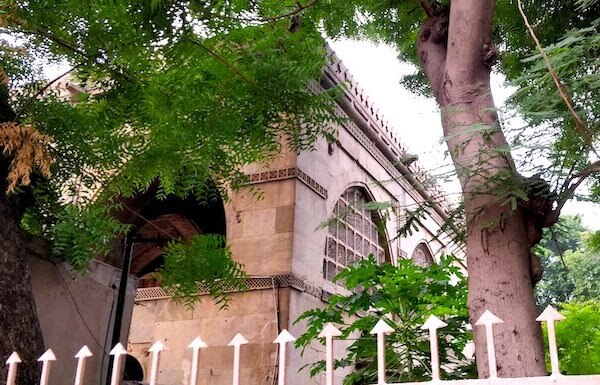
The term Sidi Saiyyed Jali refers to beautiful, ornate windows embellished with intricate latticework in stone, known as Jalis. These windows grace the Sidi Saiyed Mosque of Ahmedabad, India. The most beautiful of these Jalis have the symbolic, “Tree of Life,” carved with finesse and precision.
History of Sidi Saiyyed Mosque | Sidi Saiyyed Jali
Ahmedabad
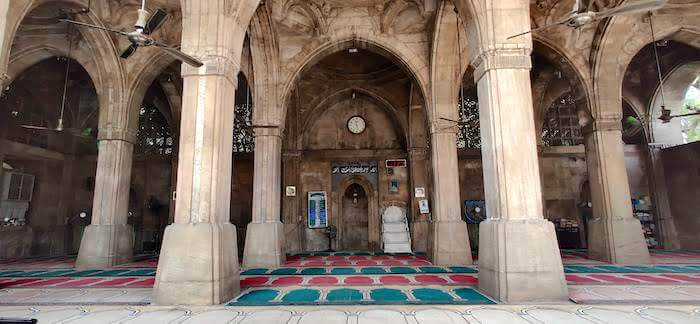
A plaque at the mosque gives a brief history of the Sidi Saiyyed Mosque. According to this plaque, the mosque of Sidi Saeed was built by an Abyssinian, by the name of Sidi Saeed, in the year 1572, AD. He came to Ahmedabad from Habshah(Ethiopia) via Yemen and was in the service of Sultan Nasiruddin Mahmud III of the Gujarat Sultanate. Sidi Saeed was known to be a kind-hearted man who did charity work and helped the poor. He was also learned and had a big collection of books.
The Sidi Saiyyed Mosque was built by Sidi Saeed during the reign of Sultan Muzaffar Shah III. Ironically this beautiful mosque with its exquisite Jalis was built at a time when the Gujarat Sultanate’s reign was nearing its end. The Gujarat Sultanate was obliterated when Akbar annexed it in the year 1573 AD.
The Grave of Sidi Saiyyed – Sidi Saiyyed Mosque Ahmedabad
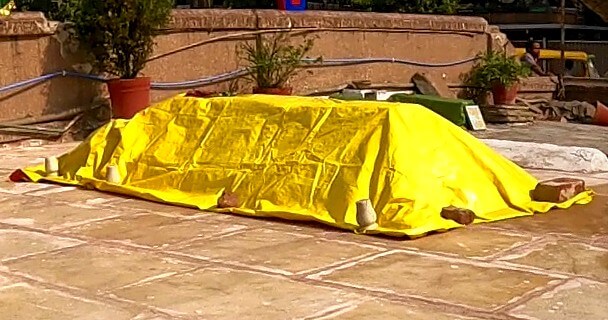
The exquisite beauty and intricate latticework in stone of the Sidi Saiyyed Jalis attract thousands of visitors. They admire and marvel at the craftsmanship of the makers of the Jalis. But very few of the visitors to Sidi Saiyyed Mosque, spare a second glance to a grave that lies in a corner in front of the mosque.
The grave is the place where the man who is credited with the building of the beautiful mosque lied in eternal sleep. The grave that lies towards the right-hand corner of the mosque, as you enter it, is that of Sidi Saeed, the man who came all the way from distant Ethiopia and left his mark in Ahmedabad for posterity.
Visiting The Sidi Saiyyed Mosque in Ahmedabad
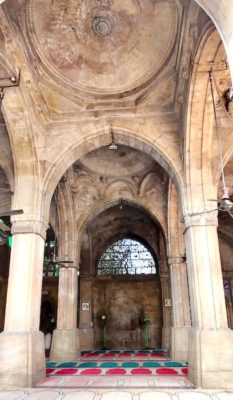
A flock of pigeons are basking in the sun, in front of a small pond that is located in front of the Sidi Saiyyed Mosque. The beautiful Jalis can be seen from the small gate that allows entry into the mosque premises. You can get a better view of the Jalis from outside, either from the road towards the western side or from a garden that is adjacent to the mosque.
Abdullah (aka Babu Painter) who is the watchman at the mosque takes it upon himself to show us around the mosque. He says that he is the fourth generation in an unbroken line, that has been taking care of the Mosque. Before him, his father, Grandfather, and Great Grandfather did service at the Sidi Saiyyed Mosque.
Abdullah points at the beautiful lattice windows and says, “take pictures of these and go home and compare with any gold or silver ornaments or any textile, you are sure to find some similarity to these designs.” What Abdullah was saying did make sense, we remembered the “Tree of Life,” design made through Rogan Art on fabric, in the village of Nirona in Kutch.
The Architecture of Sidi Saiyyed Mosque
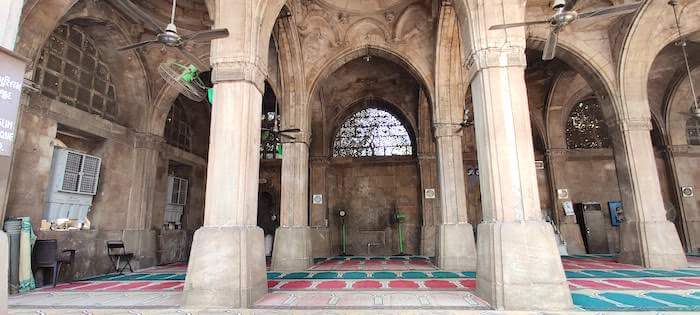
The Sidi Saiyyed Mosque is built in an arcuated style. Instead of lintels and columns, the mosque is built with the help of arches. The facade of the mosque is made up of 5 arches, and towards the posterior of these arches are located five of the latticed windows or Jalis. The central of these windows are bare and plain, a clock hangs on the wall. “There was a Jali in the centre too, but the British took it away, and it lies in London, today, volunteered, Abdullah,” however we could not really find anything online to vouch for this. What we did find was some information about the British taking photographs and paper cutouts of the Jalis to London.
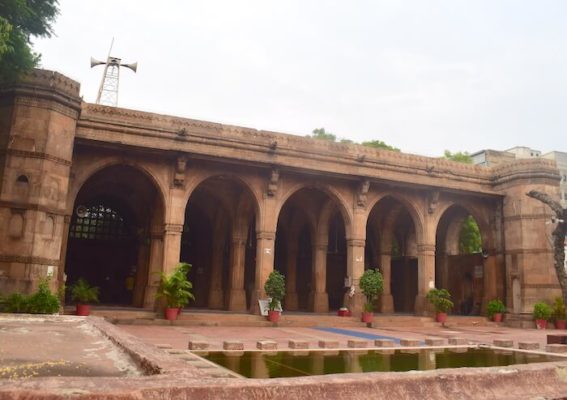
The other theory regarding the bare central arch is that the Mosque was incomplete, as Akbar annexed the Gujarat Sultanate, and so the intricate lattice carving was never done in the central arch. On either side of the central arch are the delicate and exquisite carvings of the latticed stone that depict trees with intertwining trees and branches along with foliage and palm leaves. These are famous as the Sidi Saiyed Jalis. On the far side of the central arch on either side are arches that consist of square stone-pierced panels with geometric designs.
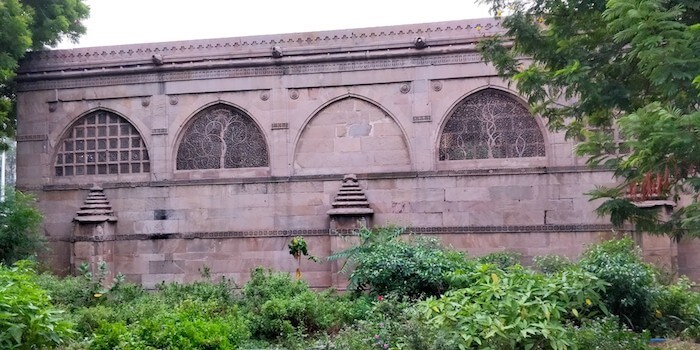
The beauty of the Sidi Saiyyed Jalis can be really appreciated from behind the rear wall. During the evening, the rays of the sun from the west pass through the lattice arches and create a surreal ambience within the mosque.
The Sidi Saiyyed Mosque stands as a symbol of the rich heritage of Ahmedabad, an example of the artistic and architectural pedigree of the city. A place that lies in a time warp, right in the middle of a city that has forged ahead, but is still rooted in its traditions.
We turn away from the Sidi Saiyyed Mosque, looking at the beautiful Jali one last time, and then our gaze involuntarily wanders towards the desolate grave that is covered with a yellow cover. Who was this man called Sidi Saeed? What was his story? And how did he come to conceive of the mosque that even today stands as a silent requiem for him? Answers to these questions lie submerged in the darkness of history, answers that may never see the light of day.
Our visit to Gujarat was part of a familiarization trip organized by the Ministry of Tourism, Government of India and Gujarat Tourism under the #DekhoApnaDesh initiative. The views and opinions expressed in this blog post are our own. #SidiSaiyyedMosque #SidiSaiyyedJali #Ahmedabad #Gujarat #GujaratTourism
Thanks for visiting our site nirvandiaries.com and taking the time to read this post.
If you wish to collaborate or work with us then reach us at [email protected]
We’d love it if you’d comment by sharing your thoughts on this post and share this post on social media and with your friends.
Follow our journey on our social media channels:
Facebook Twitter Instagram Pinterest
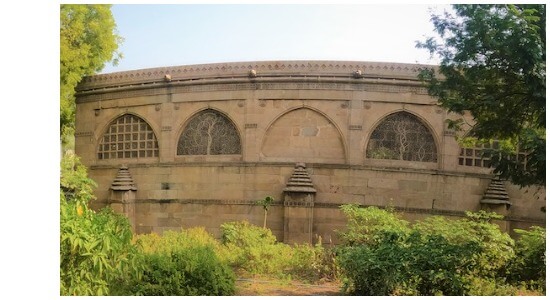


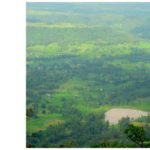
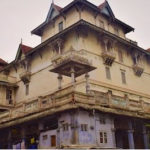

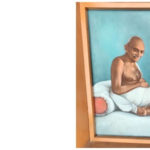
So, it’s quite amazing how people in that era were such skilled sculptors. They could turn stone into an art. The mosque looks interesting and surely worth a trip.
I really enjoy reading your articles. You explain every location with details. While reading it feels like I’m seeing it myself. Keep it up.
The architecture is actually very beautiful there. Amazing place to visit . Thanks for sharing the depth information about this place . Next Sunday I am gonna visit there as I stay in Ahmedabad itself.
Great writing! Appreciate you sharing more about mosques. Being a Catholic, it’s absolutely a new learning for me. Continue sharing informative articles like this! Happy New Year and more success!